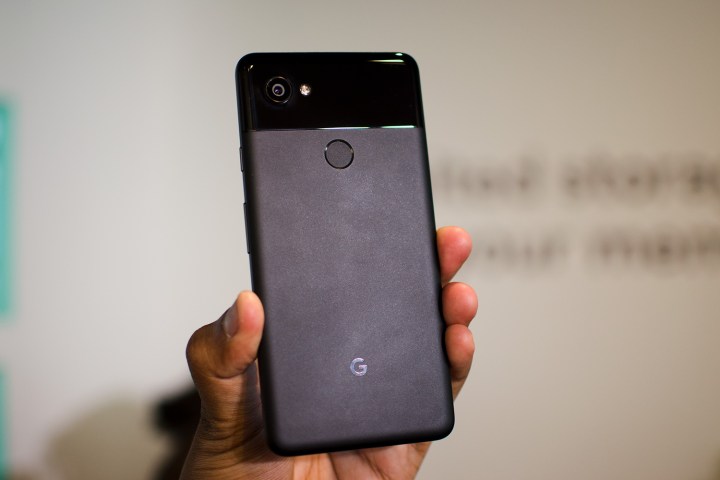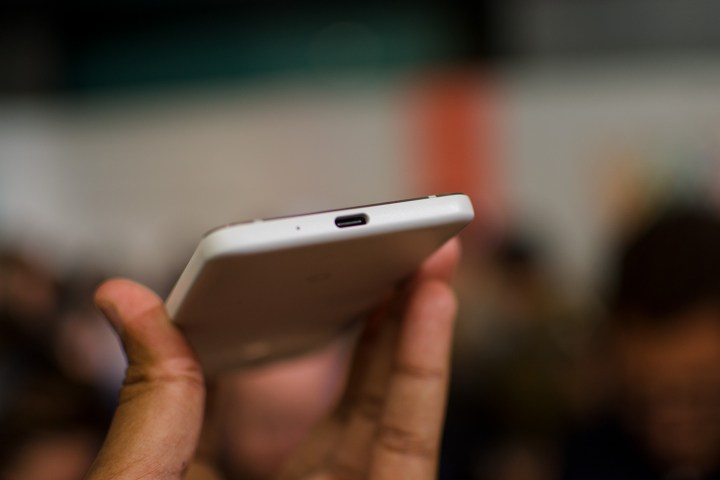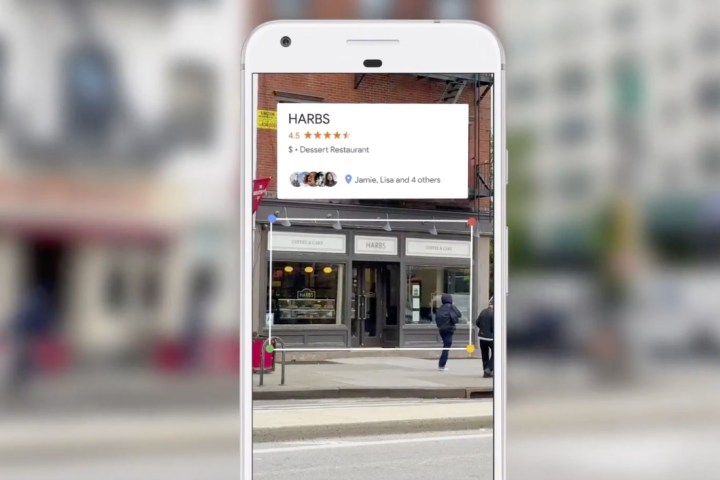
But last year’s Pixel — the first in Google’s lineup — was just as groundbreaking in its time. It was one of the first with Android 7.0 Nougat, and boasted a top-of-the-line processor, capable cameras, and compatibility with every major cellular carrier in the U.S.
So what makes the Pixel 2 that much better than the Pixel? We compared the two to find out.
Specs
| Pixel
|
Pixel 2 |
|
| Size | 143.8 x 69.5 x 8.5 mm (5.66 x 2.74 x 0.33 inches) | 145.7 x 69.7 x 7.8 mm (5.7 x 2.7 x 0.31 inches) |
| Weight | 143 grams (5.04 ounces) | 143 grams (5.04 ounces) |
| Screen | 5-inch AMOLED display | 5-inch P-OLED display |
| Resolution | 1,920 x 1,080 pixels (441 ppi) | 1,920 x 1,080 pixels (441 ppi) |
| OS | Android 8.0 | |
| Storage | 32GB, 128GB | 64GB, 128GB |
| MicroSD card slot | No | No |
| Yes | Yes | |
| Processor | Snapdragon 821, with Adreno 540 | Snapdragon 835, with Adreno 540 |
| 4GB | 4GB | |
| Connectivity | GSM, CDMA, HSPA, EVDO, LTE, 802.11a/b/g/n/ac Wi-Fi | GSM, CDMA, HSPA, EVDO, LTE, 802.11a/b/g/n/ac Wi-Fi |
| Camera | 12.3 MP rear, 8 MP HD front | 12.2 MP rear, 8 MP HD front |
| Video | Up to |
Up to |
| Bluetooth | Yes, version 5.0 | Yes, version 5.0 |
| Fingerprint sensor | Yes | Yes |
| Other sensors | Gyroscope, accelerometer, compass, proximity sensor, barometer | Gyroscope, accelerometer, compass, proximity sensor, barometer |
| Water resistant | Yes, IP53 rated | Yes, IP67 rated |
| Battery | 2,770mAh
Fast-charging |
2,700mAh
Fast-charging |
| Charging port | USB-C | USB-C |
| Marketplace | Google Play Store | Google Play Store |
| Colors | Black, Silver, and Blue | Black, Blue, and White |
| Availability | AT&T, Verizon, T-Mobile, Apple | Google Store, Verizon |
| Price | $550 | $650 |
| DT review | Hands-on review | Coming soon |
There is no two ways about it: The Pixel 2 packs a wallop. It has Qualcomm’s Snapdragon 835 system-on-chip, which compares favorably to the Pixel’s Snapdragon 821 — Qualcomm claims the former has a 27 percent performance advantage. We will have to wait until we get our hands on the Pixel 2 to say for sure, but on paper, it comes out safely ahead of last year’s Pixel in the raw power department.
The Pixel and Pixel 2 are a little more evenly matched when it comes to memory and radios. Both have Bluetooth 5.0, 4GB of
In the end, the Pixel 2’s faster processor and higher storage capacity are enough to win the specs round.
Winner: Pixel 2
Design, Display, and Durability
The Pixel 2 takes more than a few design cues from its predecessor, but look a little closer and you will notice the differences.
While the Pixel 2’s glass-and-aluminum design mimics the original, down to the curved edges, rounded corners, thick top and bottom bezels, and two-tone rear cover. The glass inlay is smaller and the fingerprint sensor is part of the aluminum body this time around. The front camera has not budged from its top-left perch on the front panel, nor has the primary camera and flash from their respective spots on the rear. There is nothing much different about the Pixel 2’s volume rocker, power button, and USB-C port, either.
The displays are mostly the same, too. Both the Pixel and Pixel 2 have 5-inch 1080p (1,920 x 1,080 pixels) P-OLED panels with higher-than-average contrast, deeper-than-average blacks, and ultra-wide viewing angles. The Pixel 2 slightly edges out its predecessor in color reproduction thanks to a wider gamut, but a Google-led effort to optimize both screens’ touch responsiveness means it shouldn’t be any less snappy than the first-gen Pixel.
That is where the similarities between the Pixel and Pixel 2 end, though. The Pixel 2 ditches its predecessor’s 3.5mm audio jack. It ships with a USB-C-to-3.5mm adapter, but it’s more of a band-aide solution than a fix. Embedded in the Pixel 2’s bezels are two front-facing speakers (one above the screen and one below it) in stereo configuration, arguably a worthy consolation prize for that missing 3.5mm headphone jack.
The Pixel 2 isn’t just louder than the Pixel — it’s more durable too. It’s IP67 certified, meaning it’ll come up unscathed after a 30-minute dunk in a 3.5-foot pool of water. That is compared to the original Pixel’s IP53 rating, which doesn’t guarantee it will withstand anything more than a few splashes.
On top of the superior water resistance, the Pixel 2 has Corning’s shatter-resistant Gorilla Glass 5 compared to the 2016 Pixel’s Gorilla Glass 4. There is not a massive difference between the two, but Corning claims that Gorilla Glass 5 is “highly” (80 percent) likely to survive drops up to 5.2 feet, while Gorilla Glass 4 peaks at 3.2 feet.
The Pixel 2 may not look all that different than the 2016 Pixel. But appearances can be deceiving. In truth, the Pixel 2 can withstand a lot more abuse, and that’s enough to win it this round.
Winner: Pixel 2
Battery life and charging

The Pixel and Pixel 2 are on par when it comes to the screens and design, and the same is true of battery life. The battery in the Pixel 2 has shrunk very slightly to 2,700mAh, compared to the 2,770 mAh battery in the original.
On the Pixel, Google pegs the battery at 19 days of standby time and up to 13 hours of 4G LTE internet browsing, which equates to about a full day of moderate multitasking. The Pixel 2 has a slight leg up thanks to its power-efficient Snapdragon 835 processor, but it doesn’t work miracles — Google says the Pixel 2 will last a “day” on a charge, which could very well end up mirroring the first-gen Pixel’s stats.
On the charging side of things, the Pixel and Pixel 2 are on equal footing. They both support the USB Power Delivery standard, which means that just 15 minutes of charging with a compatible wall adapter is enough to deliver around seven hours of battery life.
That is why we’re calling this round a tie. From what we know so far, neither phone has the advantage when it comes to battery life and charging.
Winner: Tie
Camera

There is yet another category where the Pixel and Pixel 2 are alike, and it’s the camera.
The Pixel 2 has almost the same camera hardware as the first-gen model, on paper at least. The Pixel 2 camera is rated at 12.2 megapixels, compared to the first Pixel’s 12.3 megapixels. As for the front-facing camera, they’re both rated at 8-megapixels with an f/2.4 aperture. The Pixel 2 has the same 1.4μm pixel size, the same dual pixel phase-detection technology, and the same laser autofocus sensor as the first-gen Pixel. It has roughly same video capabilities too — both phones’ rear cameras can shoot up to
But the Pixel 2’s camera is improved in other ways. It has an f/1.8 aperture as opposed to the Pixel’s f/2.0, which should translate to better low-light shots, and a Google-designed imaging chip that can apply camera filters in real time. That is in addition to a “fusion” of optical image stabilization (OIS) and electronic image stabilization (EIS), which the aforementioned imaging chip taps to counteract jerky motions while recording video.
All those improvements together were enough to earn it a 98 from DxOMark, the highest score the company has ever awarded to a
The Pixel 2’s other differentiating features are software-based. It boasts an improved Portrait Mode-like bokeh mode that captures pics with an in-focus foreground and out-of-focus background (a la the iPhone), and a Motion Photo feature that records a three-second clip before and after you tap the shutter button.

Then there’s Google Lens, an AI photo analyzer than can pick out books, DVD covers, architectural landmarks, and more. Thanks to Google-designed machine-learning chips that process more than 180 trillion floating point operations per second, Google Lens can give a description of a building in a photo, identify the artist of a painting, or even enter a Wi-Fi password automatically from a photo of the underside of a Wi-Fi router.
Google says the Google Lens will eventually come to other platforms. On a technical level, there is nothing preventing Motion Photo from hitting the first-gen Pixel — both are built into the Google Camera, the camera app that ships on the Pixel and Pixel 2. But for now, the Pixel 2 has the advantage of timed exclusivity.
It is a close call when it comes to the cameras. But the Pixel 2’s superior aperture, optical image stabilization, and wealth of software features win it the round.
Winner: Pixel 2
Software

Software is where the Pixel 2 really shines. It runs
Among the highlights is a revamped notification shade that lets you snooze incoming alerts. Notification Channels, a related feature, allows you to toggle categories of notifications on a per-app basis — if you have the YouTube app installed and you only want to see subscription updates from certain channels, for example, you can block notifications from other subscribers. Notification Badges mimic iOS’ unread badge counters — you’ll see dots appear above an app or folder with new notifications, and tapping or pressing the icon of an app with a dot show it as a pop-up.
That is all available on the first-gen Pixel, but not all of the Pixel 2’s software are heading to its predecessor. An upgraded Pixel Launcher (the app that powers the Pixel 2 and first-gen Pixels’ home screens) moves the prominent Google search bar to the bottom of the screen, where it’s easier to reach, and adds an optional “daily briefing” widget that shows the current weather, temperature, and upcoming calendar entries.

The Pixel 2’s other software exclusives take advantage of its custom hardware. The low-power Always On Display shows a monochrome clock and notifications, even when the phone is off. Now Playing taps the Pixel 2’s three-microphone array to identify music playing nearby and put a link a relevant Google Play Music listing on the lock screen. Then there’s Google’s AR Stickers, launching in preview alongside the Pixel 2, which project digital labels onto tables, chairs, and other surfaces.
There’s nothing preventing the Pixel from getting many of the Pixel 2’s software features down the line, but one feature it won’t get is the Active Edge, which allows you to squeeze the Pixel 2 to launch Google Assistant or snap a selfie, just like Edge Sense in the HTC U11. There are enough small extras to hand the Pixel 2 the win.
Winner: Pixel 2
Price and availability
Given all that’s improved in the Pixel 2, you would be forgiven for expecting it to cost an arm and a leg. But it comes in at the same launch price of last year’s Pixel.
The Pixel 2 (in “just black,” “clearly white,” and “kinda blue” colors) is available in 64GB and 128GB storage configurations for $649 and $749 unlocked, respectively — exactly the same prices as the 2016 Pixel. Alternatively, you can opt for Google’s monthly financing, which is $27.04 per month for the 64GB model and $31.21 per month for the 128GB model.
For a limited time, Google’s throwing in the Google Home Mini for customers who pre-order. But there’s a wildcard to consider: The Google Store has the first-gen 32GB Pixel for $550 unlocked, or $100 off the original asking price.
The Pixel 2, like last year’s Pixel, is compatible with every major U.S. carrier, but Google has an exclusive retail partnership with Verizon Wireless in the U.S.
Regardless of carrier, though, Google says it will support the Pixel 2 for three years — a full year more than the Pixel’s two-year guarantee.
The Pixel 2 won’t begin shipping until later this year. But here os the takeaway: It’s a better phone for $100 more than its predecessor, give or take. That is a steep price to swallow, but the durability, speed, and software improvements make the upgrade more than worth it.
Winner: Pixel 2
Overall winner: Pixel 2
The Pixel 2 is not a massive leap from the Pixel. In many ways, it’s more of an evolution. The design is more or less the same, albeit a bit more durable. The battery life and screen haven’t improved all that much, and the excellent cameras are on a fairly even footing.
But what enhancements the Pixel 2 does have are tempting. It’s more durable than the 2016 Pixel, and it’s got a faster processor and stereo speakers. Exclusive software features like the Google Lens and an all-new Pixel Launcher, meanwhile, are icing on the cake.
We will have to spend some time with the Pixel 2 before we come to a definitive conclusion, but from what we’ve seen so far, it has the first-generation Pixel beat.
Editors' Recommendations
- Does the Google Pixel 8a have a headphone jack?
- The best Google Pixel 8a cases in 2024
- The Google Pixel 8a is official. Here’s everything that’s new
- The Google Pixel 8a price just leaked. Here’s how much it’ll cost
- A new Google Pixel Tablet is coming, but it’s not what you think
